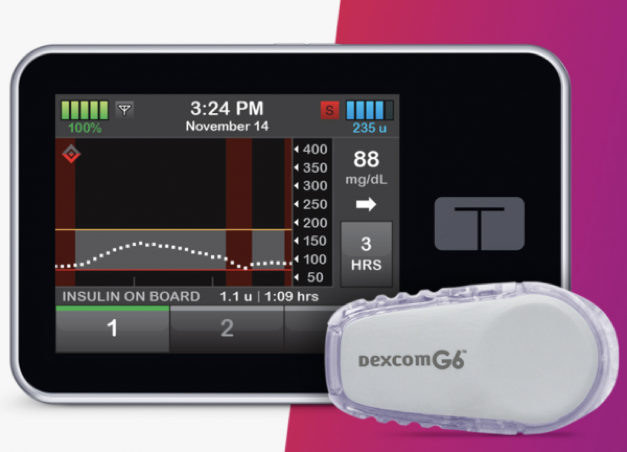FDA Approves Tandem’s Basal-IQ Predictive Low Glucose Suspend System
By Emma RyanAdam Brown
 By Emma Ryan and Adam Brown
By Emma Ryan and Adam Brown
New Dexcom G6-compatible Basal-IQ system prevents/reduces hypoglycemia based on CGM; US launch expected in August, including free software update for current users
The FDA has approved Tandem’s Basal-IQ predictive low glucose suspend (PLGS) system for people six and older. Using Dexcom G6 CGM readings and the t:slim X2 pump, the new PLGS algorithm stops basal insulin delivery when low blood sugar is predicted (within 30 minutes) and resumes insulin delivery once blood sugar levels start to rise. The goal is to prevent or reduce time in hypoglycemia (low blood sugar) – and it does so without alarms. Study results presented in February showed that Basal-IQ reduced time in hypoglycemia (below 70 mg/dl) by 31%, or about 19 minutes per day.
In exciting news, Basal-IQ will be compatible with Dexcom’s new G6 system. Tandem originally submitted Basal-IQ with G5, though the FDA was forward-thinking here and approved use with the just-launched G6. This represents the first automated insulin delivery system compatible with a no-fingerstick-calibration CGM. Basal-IQ will not work with G5, meaning current t:slim X2 users will need to upgrade to G6 to use the new algorithm. (See here for our test drive of the G6.)
Basal-IQ will begin shipping in August, and current t:slim X2 pump users within their 4-year warranty will get a free remote software upgrade to add the Basal-IQ algorithm – no new hardware or expensive upgrade fees! Current t:slim X2 users will need a new prescription, however, and must complete 45 minutes of online training and will have to order supplies separately from Tandem and Dexcom.
CGM remote monitoring will be possible with Basal-IQ, since the Dexcom G6 transmitter can send values to both the pump and the G6 smartphone app at the same time. The t:slim X2 can also be used without Basal-IQ or CGM, if a user desires.
FAQs
How Does the Basal-IQ algorithm work?
Using Dexcom G6 CGM values, the algorithm looks ahead 30 minutes and suspends insulin when glucose is predicted to drop below 80 mg/dl or if glucose is currently below 70 mg/dl and falling. The system resumes basal insulin delivery once glucose values start to rise – without alarms.
Basal-IQ works silently in the background without “modes” – No additional alerts or alarms are required to use Basal-IQ, and users can choose whether or not to receive alerts when insulin is suspended/resumed. This is a big win, especially overnight. Additionally, the Basal-IQ feature is only toggled ON or OFF, operating without a need to juggle different modes. Both of these are advantages over the MiniMed 670G hybrid closed loop, which some find alarm-heavy and attention-demanding to remain in Auto Mode.
How is Basal-IQ different from a hybrid closed loop? When will Tandem have a hybrid closed loop?
Basal-IQ is essentially the bottom half of a hybrid closed loop, as it reduces hypoglycemia by suspending insulin delivery when a low is predicted. However, Basal-IQ will not increase basal insulin delivery for high blood sugars, nor will it automatically deliver a bolus for high blood sugars. However, Tandem is entering a study of exactly this kind of hybrid closed loop, Control-IQ, which it hopes to launch in the first half of next year. Control-IQ could be the first automated insulin delivery system to add automatic bolusing for high blood sugars, in addition to automatic basal. Control.IQ will use the same t:slim X2 pump and Dexcom G6 CGM.
What about an app for viewing insulin pump data?
Tandem hopes to launch a t:slim X2 mobile app in the second half of this year, which will allow users to view pump data on their smartphone without having to pull out the pump. The app will also automatically upload insulin pump data to t:connect, Tandem’s data management system.







